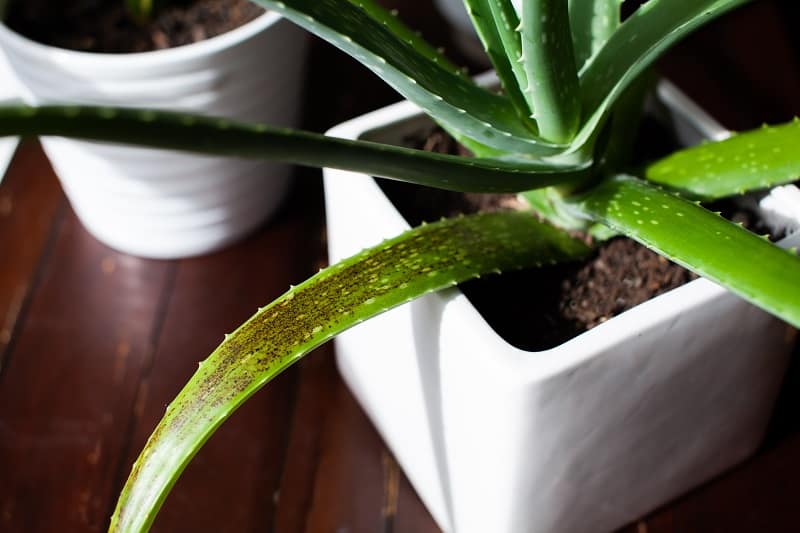
The most common reason for aloes to die is due to overwatering.
Aloes are succulents that come from the driest places on earth. They have evolved to thrive in places with high temperatures and little to no rain. Succulents are able to absorb a lot of water when it rains and they store that water in their bodies and leaves. These water stores are what they use up when a drought comes around.
It is very easy to overwater an aloe plant, especially if you do not check the soil regularly. If you establish a watering schedule that your aloe plant likes, your plant will bounce back.
How can you tell if an aloe plant is dying?
Leaves turning brown and becoming soft
When you overwater your aloe, use soil that does not drain well, or use a pot that has no drainage holes at the bottom, your plant can get root rot. The first signs of root rot are leaves turning yellow or brown and becoming mushy to the touch.
Aloes are drought-tolerant plants that do well in full sun and porous soil with infrequent rainfall. So, the best way to make sure your aloe plants thrive is to simulate the living conditions they might have in their natural habitat.
You can remedy an overwatered plant by extending the time between watering. If you are watering your aloe once a week and it looks overwatered, try watering it once every 10 days and see if it starts getting better. The best way to check whether to water your aloe is to stick your finger into the soil. If the top inch of the soil is dry, that means you need to water it. If it is still damp, you need to wait a few more days and check again.
Another step you can take is to replace the soil. You cannot use pure gardening soil for an aloe because it is too dense and retains too much water. Aloes need to have sand and perlite in their soil to make it more porous and quick-draining. Make sure the pots you use have drainage holes at the bottom to help get rid of any excess water from rain or when you accidentally overwater.
Not enough sunlight
When aloe does not get enough sunlight it will start to droop and its leaves will start dying, starting at the base. They need between four to six hours of sunlight every day to remain upright. The aloe plant may even become leggy from its desperation to reach the nearest source of light.
When you put your aloe in the shade, its leaves can become weak and long, and its color will become paler. The leaves at the bottom will start to brown in order to salvage the leaves at the top, because those are the ones that are closer to the source of light.
You can remedy a drooping aloe plant by gradually exposing it to more sun. Look for a spot in your home that gets four to six hours of sunlight each day and place your plant there. For the first four weeks, alternate placing the plant there and in the shade. Placing the aloe in a sunny spot suddenly can cause sun damage because it was not given time to adjust.
If you see the outer leaves drooping, it may be best to cut them off completely in order to allow new leaves to grow.
In the case of an aloe that has been deprived of sunlight for too long, with most of its leaves unable to keep themselves up, it may be best to take cuttings from the healthiest leaves and to propagate them.
The plant is getting too much sun
As mentioned above, aloes need between four to six hours of light everyday, but if they get more than that the plants can turn brown from sun damage. They need to be transferred to another area where they can take a break from the sun for the majority of the day.
This is most evident in plants that were bought from a store, where they have become used to the shade. The aloe in this case has adapted to that environment, so when you take it home and plant it in a garden or place the potted aloe under full sun, the sensitive leaves will burn and turn brown.
These plants need to be slowly introduced to the full sun by adding more and more sun exposure each day until they have adapted.
If the aloe has brown or burnt leaves, you can just cut the tips off because they will not recover or turn green again.
The plant is not growing
Sometimes you might notice that your aloe does not seem to be getting bigger or growing any leaves. It is understandable for you to worry, but usually, there is nothing wrong with your plant.
It could just be that your aloe has gone into dormancy because it is summer season. Aloe plants go dormant and stop growing in order to conserve the water they have stored, especially during times of intense heat and drought.
They stop growing because the plants need to channel all of their energy and resources into keeping themselves alive.
You cannot really do much during this time, so just wait until the weather becomes cooler and the aloe plant should continue growing then.
Conclusion
The most probable reasons your aloe plant is dying are overwatering, not getting enough sunlight, or getting too much sunlight.
Fortunately, all of these problems can be remedied quite easily.
It is also possible for you to think that your aloe is dying because it is not growing, when in fact it has just gone into dormancy.
Image: istockphoto.com / Ashley-Belle Burns